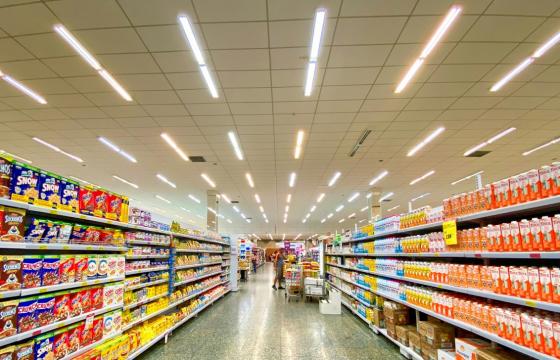
Winter is coming! As the clocks turned back on the weekend, marking the end of British Summer Time, we all feel the shift.
Energy awareness grows, and the focus on energy bills sharpens during these colder months. Between 2019 and 2023, the number of smart meters in UK homes more than doubled (+114%), signalling a shift in how households monitor and manage consumption. As energy prices dominate the headlines again, households aren’t the only ones keeping a close eye on usage.
For food retailers with vast estates, this challenge is even greater. With shorter days and longer nights, lighting costs soar, and businesses are seeking ways to stay ahead of these rising energy expenses. The astronomical clock may be ticking, but smart technology offers an opportunity to cut costs, improve efficiency, and bolster profitability during the long, dark winter days.
First steps to improve lighting efficiency
Food retail stores rely on well-lit spaces during operating hours to create a welcoming ambiance and meet customer expectations for comfort and visibility. Retailers, known for their innovation, have already taken positive strides to increase lighting efficiency and reduce energy costs. For example, the widespread adoption of LED lighting was a vital step in reducing wasted energy through inefficient systems.
Many supermarkets also use scheduled timers to control lighting, dimming or turning off systems to avoid unnecessary energy consumption. However, with sunrise and sunset times constantly shifting, timers can often drift into inaccurate routines, leading to inefficiencies. Furthermore, retailers operate in complex, ever-changing environments and need technology that adapts in real time. For instance, during the COVID-19 pandemic, stores had to quickly (and largely remotely!) adjust their lighting to reflect changes in footfall, opening hours, and staffing.
Moreover, external lights, such as those in car parks, are another essential area for efficiency improvements. While photocell sensors are commonly used to adjust lighting based on daylight, they require frequent cleaning and maintenance. Dust or debris can quickly accumulate on the sensor lenses, disrupting performance and leading to time-consuming maintenance calls or expensive sensor replacements. These sensors can also be unintentionally interfered with by natural elements, for example, artificial light, fog, snow and even bird droppings! This can cause sensors to misread light levels, leading to inefficient adjustments.
Taking energy and cost savings a step further
While these current solutions help retailers track data and increase efficiency, further cost savings require more targeted, context-specific strategies. IoT applications like IMS Evolve’s advanced solutions take lighting optimisation to the next level by enhancing current operations to optimise both interior and exterior supermarket lighting.
IMS Evolve’s software solution can be deployed as a digital layer over existing infrastructure, collecting real-time data that monitors and manages everything from faulty lights to scheduling drift. Acting as a 24/7 ‘engineer,’ it continuously analyses machine performance and flags inefficiencies.
These smart solutions can automatically adjust lighting schedules in real time, aligning with astronomical clock data and factoring in relevant variables such as weather, occupancy, and time of day. This ensures maximum efficiency, regardless of season or conditions, and drives peak efficiency.
Crucially, IMS Evolve’s approach to lighting forms part of our solution that monitors various other store assets including HVAC, refrigeration, CCTV, and ATM’s. This holistic store approach creates a unified system that transforms store management. By reducing energy consumption across multiple assets, this comprehensive approach enhances customer experience, cuts costs, and delivers rapid ROI to strengthen the retailer’s bottom line – even through the most challenging and costly times.
Digitally upgrading retail stores
This isn’t simply a case of out with the old, in with the new. Food retailers have already made significant strides toward efficiency across their estates. But IoT and digital technology can drive these improvements even further, enhancing energy efficiency and unlocking additional cost savings.
IMS Evolve’s proven IoT solution is control-agnostic, which means it can connect to any addressable device, regardless of manufacturer or age, and integrate it into their IoT layer. So, where traditional monitoring and control systems are limited to connecting to the latest assets or machines made by the same manufacturer, IMS Evolve’s technology removes manufacturer dependency and enables any and all devices to be brought into a modern, digital system. This flexibility makes it easier and more cost-effective to bring older assets into a connected world without needing upgrades and replacements.
Whole store digital transformation
As winter brings shorter days and higher energy costs, food retailers must prioritise total store efficiency to stay competitive and protect their bottom line. IMS Evolve’s IoT solutions empower organisations to harness real-time insights, optimising lighting schedules to align with the changing astronomical clock, boosting efficiency, and reducing costs.
By deploying a control-agnostic IoT layer over existing infrastructure, IMS Evolve enables digital transformation across nearly any machine, regardless of age or manufacturer. This adaptability ensures that food retailers are equipped to meet the challenges of winter head-on and achieve meaningful savings that support sustainable growth.